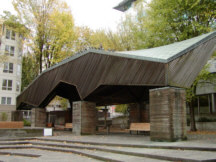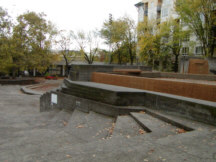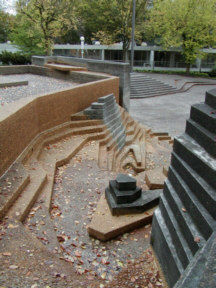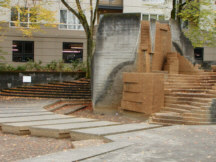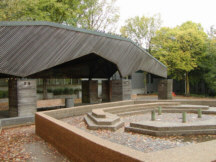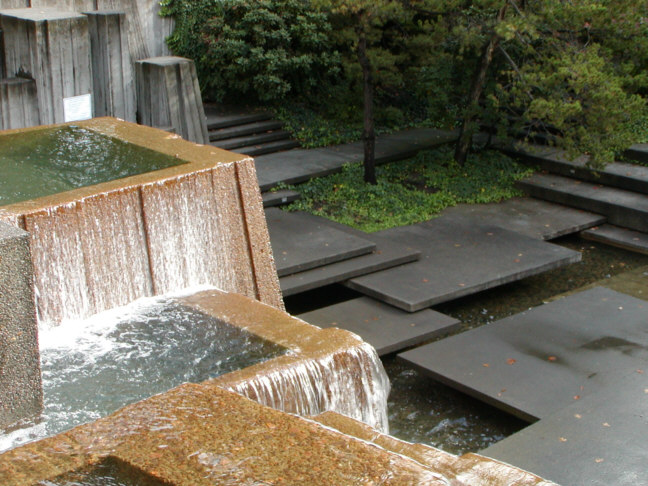
The Ira Keller Fountain
Portland Oregon
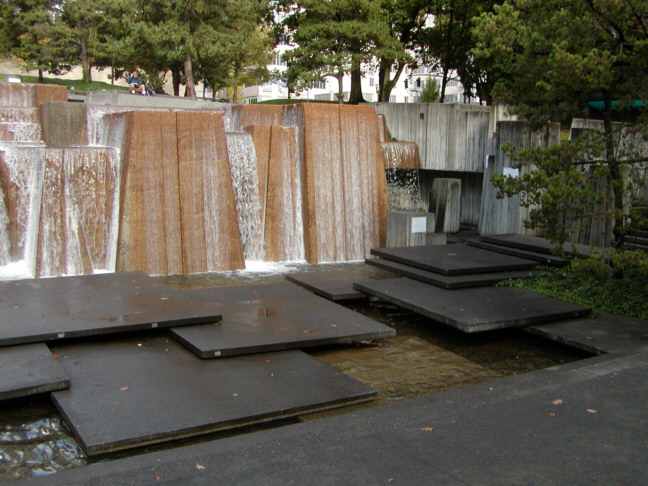
|
Like the Apollo program, the Ira Keller
fountain in downtown Portland Oregon is an accomplishment from the 70's
that we as a society could now barely manage. It's a loud and playfully
interactive physical expression of civic values that today seem too
liberal and humane to be true, and, in that wonderful sneaky ability
of environments to set our social expectations, it perpetuates those
values. Protecting this fountain has a practical social benefit.
The Keller Fountain exists in what landscape designer Lawrence Halprin describes as an eight-block interconnected complex of walkways and urban interfaces in Portland, but the rest of the system is easy to overlook, at least in its current state. Moving from south to north the sequence of fountains is Lovejoy - Pettygrove - Keller, with connecting and adjacent pedestrian avenues and channels, carefully planted and landscaped and vaguely European. |
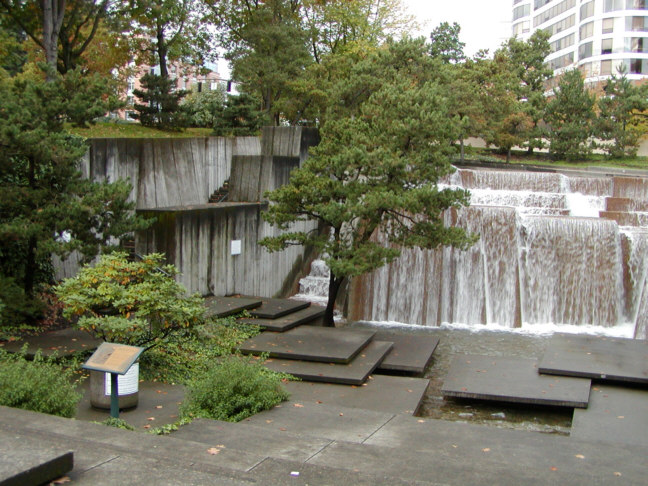
|
In 1981's Process Architecture, Halprin described his intent this way: In Portland I attempted to do two things: the first of these was to develop a long eight block sequence of open spaces, promenades, nodes of plazas and parks with a mix of public space and private space interwoven. Along this progression are a diversity of uses - housing, apartments, shops, restaurants, offices, auditorium. The space is choreographed for movement with nodes for quiet and contemplation, action and inaction, hard and soft, yin and yang. The second basic approach was to bring into the heart of downtown activities which related in a very real way to the environment of the Portland area - the Columbia River, the Cascade mountains, the streams, rivers and mountain meadows. These symbolic elements are very much a part of Portlanders' psyche…. Finally these places were for the first time designed to be used to be participatory - NOT just to look at - they say COME IN, not stay off. One source has it that the "Lovejoy Fountain was the center of a lively youth culture in the 1960's," which is impossible, given its 1971 construction date. But this fountain as a popular halfway-ceremonial gathering place for "lively youth culture of the 1960's," yeah, I totally believe that. |
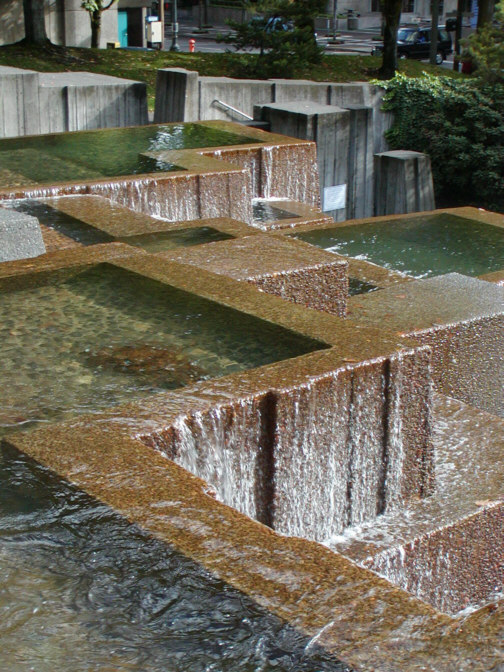
|
The cool thing about Halprin is that he is 88, still going strong, recently finished the FDR Memorial in Washington DC and the Yosemite visitor re-design, is a Pacific Northwest individualist, a kook teacher, landscape designer important to the profession, author of multiple books and dozens of projects, and an acknowledged master of his art still dangerously unpredictable. It's not far off to think of him as the equivalent of Robert Altman. Halprin's work has always been marked with attention to human scale, user experience, "humanistic" values and an eye to the social impact of his designs, in the egalitarian-landscape tradition of Frederick Law Olmsted. This location was meant for your enjoyment, for the use and benefit and enjoyment and convenience of the general public. That's a strong idea with deep roots. Here at this civic park, that tradition is meaningful and treasured. In San Francisco, at Halprin's transient-ridden United Nations Plaza, Halprin's design has been a chronic, embarrasing, expensive failure. In Seattle, at Seattle Freeway Park, it's been kind of a cherished failure. |
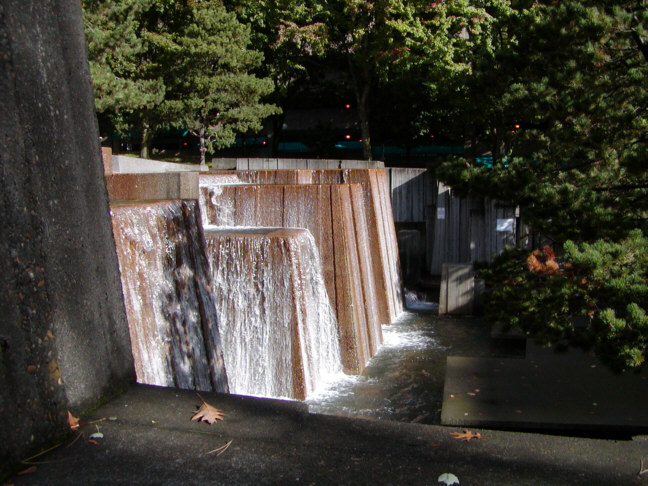
|
Most of the eight-block pattern in Portland is, sad to say, excruciatingly out of style. The other two fountains, the Lovejoy and Pettygrove fountains, are ground-level amenities for Portland Place, an HOK or SOM high-rise master-planned residential development with three apartment towers. The Lovejoy is also Halprin's work and 'playable'; the Pettygrove is not. Portland Place reeks of the master-planned late 60's, like Crown Center in Kansas City, a superblock design solution from a former era. When you spot certain kinds of large glass globes, certain kinds of bollards and outmoded trash cans, you know what to expect. Some of the outdoor civic furniture in Portland Place seems to suggest that humans constantly put on impromptu ritual performances for each other, and some of the grassy platforms seem tailor-made for mimes, in macramé denim vests and rainbow toesocks, to writhe in the last agonies of a fondue overdose. Another relic of the seventies. |
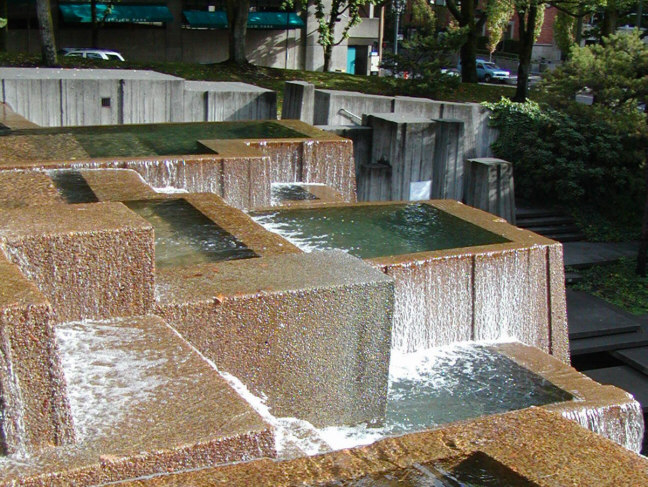
|
Halprin's elaborate 1966 Lovejoy fountain, which supposedly invokes both Oregon streams and the Trevi, was dry and full of leaves the day of our visit, so I can't tell you how playful & interactive it is, or its feeling. The water here would flow down short and irregular steps as if from a contour relief map, and the whole fountain sequence is not as sheltered by its surroundings. It is bedeviled by skateboarders, they say. And at the head of Lovejoy is a startlingly ugly wooden pavilion designed by Charles Moore and William Turnbull -- startling because Moore, Turnbull, and Halprin, among others, had all collaborated on the beautiful and architecturally important Sea Ranch development in the Bay Area. As to the Lovejoy pavilion, I'm thinking Mixmaster Moore bit off more than he could chew, in the 70's style language of the Pacific Northwest, that style that produced so many oak beams, chunky bridges, deep casement windows and monopitch shingle roofs across the country that even in my St. Louis suburb some of my friends' houses looked like prisons for lumberjacks. Another relic of the seventies. |
|
Lovejoy Fountain click for bigger images |
||
|
Your first experience of the Keller
Fountain, on the other hand, is the sound of rushing water. It has not
aged in the same way as its surroundings. The Keller is still alive
and cranking out a compelling wall of sound.
|
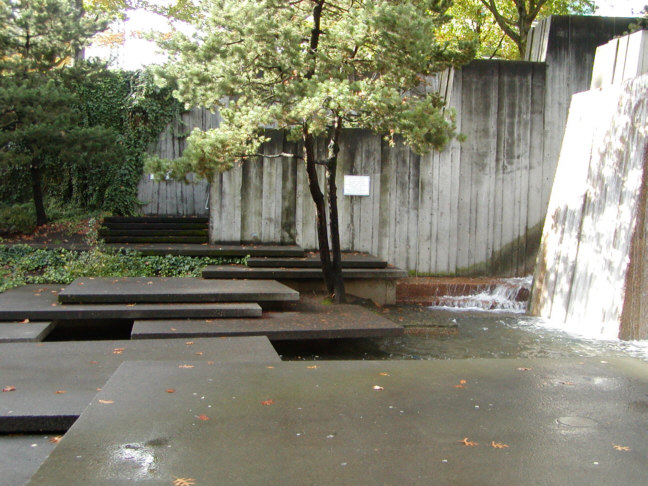
|
It occupies a whole (small) city block, .92 acres, between 2nd and 3rd and Clay and Market, and circulates 13,000 gallons of water a minute. Visually the Ira Keller Fountain suggests a remembered, stylized, simplified, sense-memory of some wilderness waterfall canyon experience you never quite had. There are three sections, three experiences. The deep lower collecting pool is accessible from those large overlapping stone squares, arranged in that beautiful irregular regularity, and shaded. The blocky parapets of the falls themselves are the most dramatic attractive and photogenic, sunny and sparkling and loud too, and to either side of the waterfall you have secretive and deeply inset sets of pedestrian steps. Climb those steps, and you'll find the third section, an upper plane before the falls, where rapid streams emerge from underfoot, in crevices and interruptions under the pavement, rushing off to the falls. |

|
As you advance towards the water in
the collecting pools, you might wonder if you can trust you own sense
of privilege, if you're really allowed to do this. Trail your fingers
in the fast flow up top, perch wet or dry atop the falls, wade barefoot
into the bottom, or climb. You're operating in that wonderful audio
cocoon-bubble of privacy created by the loud rushing water, behind
or maybe inside that wall of sound, so you feel alone and brave.
Eventually you give yourself permission. Or you don't. You decide how
brave you want to get, or not. It's a detail, but many have commented
on that moment. As civic planner Barbara Duncan wrote:
Coming from another urban area (Oakland-Berkeley) a number of years ago my first reaction to Ira's Fountain was slack-jawed disbelief. The thing most striking to me was its absence. Where were the signs saying 'keep out,' 'danger', 'caution', 'no swimming'? There were no warnings or precautions visible. Did the lawyers know about this? How do they pay the liability? I was charmed, impressed and fell totally in love with the city of Portland at that point. Charmed that they cared enough to give over this energy and space to a non-revenue generator… To this day, many years since, I would name either the Salmon Street Springs or Ira's Fountain as my favorite spots in the entire city. It is the joy factor of watching people interacting with the water. The kids especially are surprised that it is O.K. to go in. They look around as they approach the fountain, half-expecting someone to yell, 'Stop, don't touch that!' |
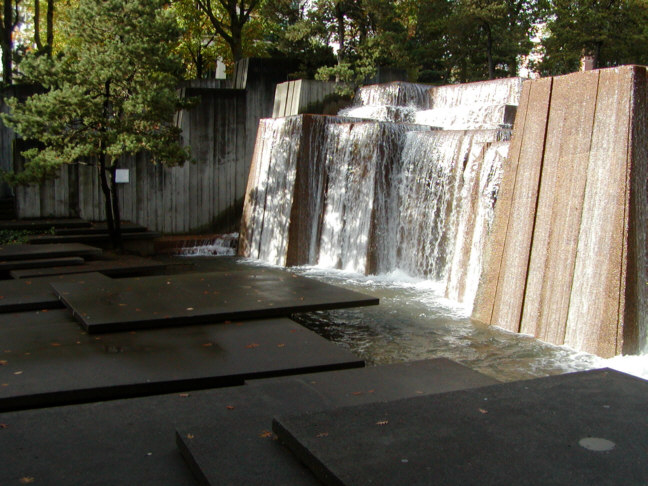
|
At 35 years old you wonder what kind of structural condition it's in. The poured concrete has soaked in an unknowable amount of Portland rain. But it looks aged, distinguished, with an Aztec inevitability and permanence, striated grooves and sturdy angles easy to imagine carved from clay. (Don't worry - it was re-habbed in the mid-1990s.) Angela Danadjieva was the actual designer on Halprin's staff, reportedly from a clay scale model and tightly designed around the dimensions and capabilities and preferences of humans as they tend play in water. They say she analyzed the movements of dancers, so there are anthropometrics baked in to these shapes and gaps. (Halprin's wife Anna has been a noted avant-garde dancer since the 1940s, with whom he has explored the borderland between choreography and the way pedestrians move through a public space, to the point of developing a special motion-oriented notation, like dance notation, called "motation". Halprin developed this with Robert Perron at UC Berkeley, a description of the physical environment on either side of the bee-line of a subject, an approach to describe the impact and attractions of architecture. As this site mentions, "he had written several books that developed his theories for "scoring" public spaces in a self-styled musical notation of movement, Jungian psychological theory and pure '60s mysticism." Hah!) I love that moment in this fountain when you find yourself engaged in a conversation with the designer, I can step across this 12-inch mossy slick gap but this one's too wide, I can climb this but not this, this area is meant to be accessed through this path, a conversation when you discover the designer's intent, technique, and spatial repertoire. But there are blue and white signs to protect you. Or to protect somebody. There's a bunch of them. |
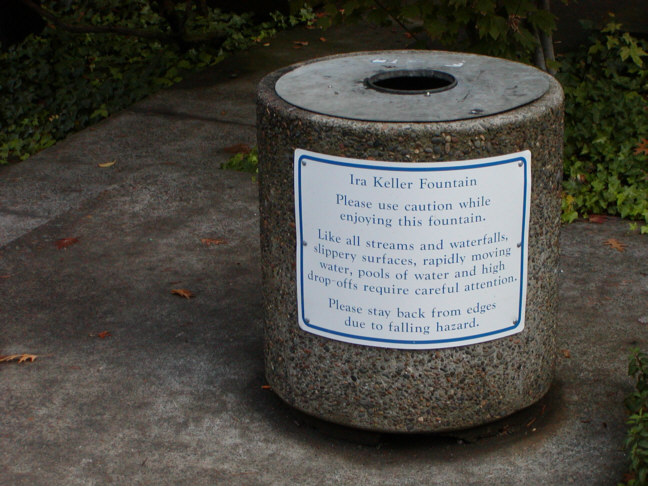
|
It's not that two dozen of these blue and white signs are bradded down to trashcans, a visual blight, and not only that they're a reminder of how we must bow to the most feeble-minded among us, our intelligence insulted and self-respect undermined in a reverse Darwinian triumph of the timid and dull-witted and most-ligitious, and oh my God I HATE being nagged down to. It's not that. It's that the verbal message of those signs is so effectively contradicted and drowned out by the bravery, openness, good sense and loud sexiness of the water, that's the best part. There are no railings or fences. The place is untamed and attractively dangerous, like the natural world. It is not ADA compliant. The place seems to be daring you onto its dangerous, irregular, slippery surfaces. Physically, it's not as dangerous as it looks. Designed
as an interactive plaything, it conceals its own inherent safety devices.
But it's dangerous from the standpoint of liability law. You could
crack your head open very easily, and lawyers would come out. And
it's dangerous to provide this kind of civic amenity to just anybody
who wanders up (dear Portland, when you begin handing out free roast
beef sandwiches please let me know) and more dangerous than anything
else is this message of risk and self-determination and joy. Whether
or not that's another relic of the seventies, you tell me. |
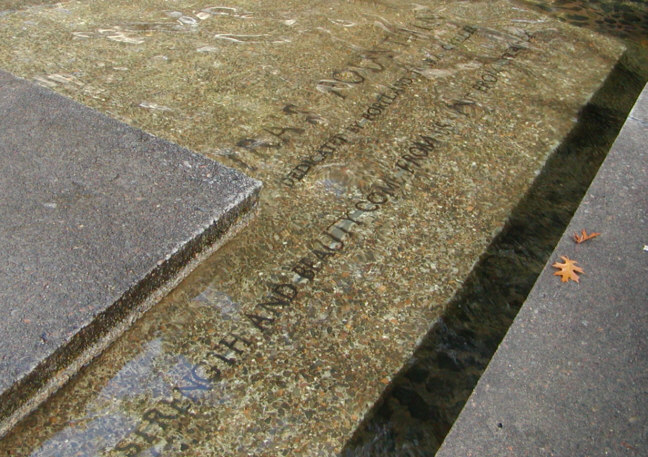
|
Lawrence Halprin died on October 25, 2009. The mission of the Halprin Landscape Conservancy is to activate, improve and maintain Halprin's work in the City of Portland. If you value the fountain, pay them a visit. And you know what? Portland Commissioner Randy Leonard stole the top photograph from this page and used it on his blog posting July 23 2010. You'd think he'd know better. You'd think he, or somebody on his staff, would have answered my polite emails asking him to credit me or take it down. Shame on you Commissioner Randy Leonard shame. |
|
And if you've enjoyed reading, please contribute via
PayPal. Your contributions help keep this site going and are appreciated.
Truly.
|
![]()
Copyright 2005 - 2009 Walt Lockley. All rights reserved.
